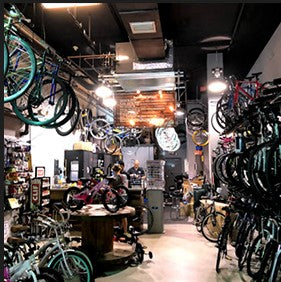Internal Gear Hubs vs. External Derailleurs
November 07 2016 – Ezekiel Binns

Aside from their comparable debut dates, the only other similarity internal gears and external (gears), or derailleurs, have in common is their mutual function of shifting gears. Both were engineered around the time of the 20th century, with a 2-speed hub being patented by William Reilly of England in 1896 and the derailleur developed only nine years later by Paul De Vivie of France in 1905. During the 20th century internal gear hubs trailed behind external gear cassettes and derailleurs, offering only a small variety of gears per hub consequently limiting the variety of ride speeds and styles available to the rider; where internal gear hubs held 2 to 3, externals held numbers approaching ten. Today, regardless of what type of model or make, if your bike shifts gears then it's using either system to do so. Although both systems of shifting gears have their advantages, internal gear hubs are becoming all the more preferred, competing with the prevailing derailleur system on several fronts.
Shifting: Perhaps the most significant difference of internal gear hubs is its ability to shift stationary. On the traditional derailleur the rider must be pedalling in order for the mechanism to shift into a higher or lower gear. Internal gear hubs offer the ease of being able to change gears whilst being stationary proving to beneficial in scenarios such as finishing off a ride in a speed that’s straining to start the next ride with. With a derailleur, the rider would have to pedal through it and eventually get to the desired lower gear, increasing the possibility of early fatigue or cramps. With an internal gear hub, the rider can casually adjust his or her bike without rotating any pedals in order to start their ride off comfortably.
Lifespan and Maintenance: Derailleurs trail in comparison to internal gear hubs when it comes to maintenance, handling and lifespan due to the particular reason of it being external, and therefore exposed to all the glory that roads, trails and treks grant. Riding routinely with a derailleur takes a substantial amount of commitment and responsibility that internal gear hubs don't really require. Derailleurs require regular attention, consisting of thorough cleanings, technical adjustments and occasional chain replacing. Internal gear hubs on the contrary, although requiring some maintenance as all bikes do, require a significantly lesser amount. Having only one rear cog, internal gear hubs don't have to pass series of cogs resulting in the flexing, bending and occasional jamming of the standard derailleur. Forces such as those recently mentioned typically results in shorter life spans due to the chains strain and eventual loosening, a problem less occurrent to those with the benefit of having the straight chain line that internal gear hubs feature.
Reliability: Due to the inherent nature of being contained, in this case by a hub, bikes with internal gear hubs are less prone to having their gear damaged or worse, system knocked out of alignment. The majority of moving mechanisms such as the varying gears are concealed within the shell of the hub, shielding some of the most fragile yet vital parts of the bike. Bikes fitted with internal gear hubs also come with the option of adding additional protection to the drivetrain through the use of a chainguard, an option derailleurs do not offer due to the shifting chain lines. Even with the additional chainguard, internal gear hubs feature a lower complexity that's all around more appealing to the eye and mind; there is no bulky chain tension adjuster, nor is there a long, lanky chain being seemingly suspended. The removal of all these features results in a removal of risk and therefore, comfort of mind that one's bike and its minimal parts will be easily maintained and properly functioning. Although derailleur systems are often times more economical, the long lasting durability of an internal hub will pay for itself in the long run.
With these factors in mind, and the additional fact that internal gear hubs now feature a wider variety of cog sizes and numbers there’s no questioning why its presence has been increasing at a climbing pace.
Loco Cycles has expanded its product line from only carrying single speed styles to now offering 7-speed option (derailleur) for the Beach Cruiser line and 5-speed option (internal gear hub) for the FG Cruisers® line.

